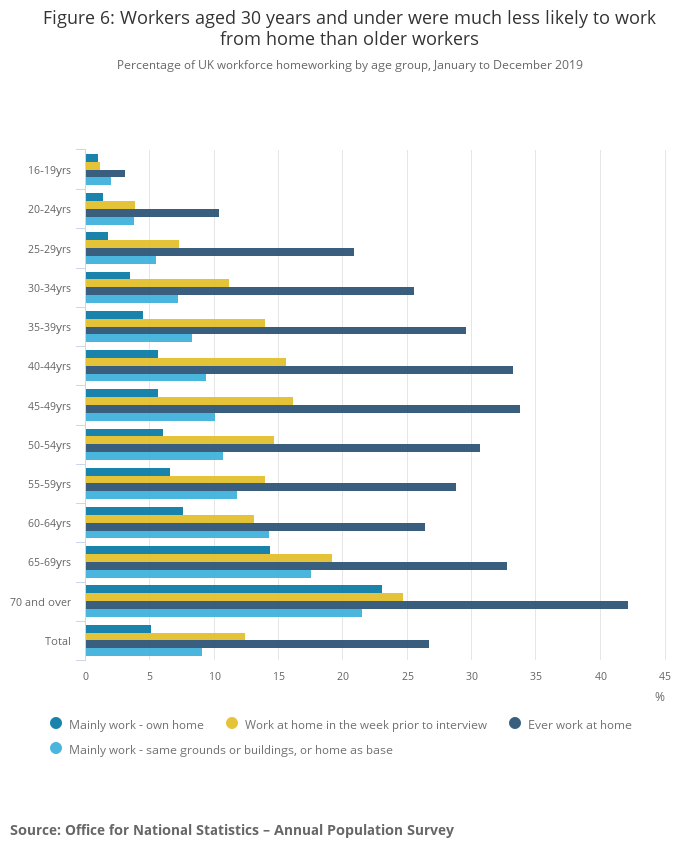One major impact of the COVID-19 crisis has been the dramatic shift in working patterns as many people have been forced to work from home.
The UK Government announced on March 23 that the country was going into lockdown and that, key workers aside, employers should take every possible step to facilitate their employees working from home, including providing suitable IT and equipment to enable remote working. Analysts have reported that the pandemic has lead to a surge in video conferencing app downloads, such as Microsoft Teams, Google Hangouts and Zoom.
As yet, reliable data on how many people in the UK are now working from home during this time is unavailable but a recent statistical release from the Office for National Statistics (ONS) provides details of how the trend towards homeworking was developing prior to lockdown,
The data comes from the Annual Population Survey (APS) 2019 which covers the 12 month-period from January to December 2019 and is based on questions asked to a sample of selected people . The UK Data Service holds the APS data from previous years since it began in 2004 and will make the 2019 datasets available as soon as they are released.
The Annual Population Survey (APS) 2019 shows that during this period, of the 32.6 million people in employment, around 1.7 million people reported working mainly from home, with around 4.0 million working from home at some point in the week prior to the interview. Meanwhile, 8.7 million people say they have worked from home and 2.9 million people work either in the same grounds or buildings as their home or use home as a base (Figure 1). ONS data also shows that over the last five years, the proportion of people who say that they mainly work from home has increased (Figure 2).


Industries of homeworkers
The extent to which people can and do work from home varies by industrial sector.
For example, in both the transportation and storage sector and accommodation and food services sector, where it is difficult for people to work from home, only around 10% of people report ever being able to work from home. These two sectors include rail, road, air transport, shipping, warehousing, postal activities, hotels, bars and restaurants (Figure 3).
In contrast, around 50% of people working in the information and communication sector and the professional and scientific sector reported that they have worked from home as well as high percentages of people who had done so in the week prior to the interview.
The two largest industrial sectors, accommodation and food services and health and social work, account for over 25% of all employment but only around 16% of the people who have ever worked from home.

Occupations of homeworkers
Nearly 80% of those who worked from home in the week prior to the interview, or who ever work from home, came from the first three major occupation groups (managers, directors and senior officials; professional occupations; associate professionals and technical occupations), while these groups constitute less than 50%of total employment.
These three major occupation groups are also the highest-earning major occupation groups, suggesting that higher-paid workers are more likely to have the ability to work from home than lower-paid workers.(Figure 4).

Regions of homeworkers
People who live in the South East are the most likely to work from home, ahead of those who live in London or the South West. In 2019,those working in the South East were over twice as likely to work from home at some point during the week as those who lived in Northern Ireland, Scotland or the North East (Figure 5).

Age of homeworkers
Workers aged 30 years and under are much less likely to work from home than older workers. They are also less likely to work in the same grounds or buildings as their home or use home as a base. Meanwhile, those that keep working beyond State Pension age are far more likely to work from home than those below that age (Figure 6).

Sexes of homeworkers
There are not very large differences between the percentage of men and women working from home, with women a little more likely to work mainly from home while men are a little more likely to have worked from home at some point. However, men are over twice as likely to work either in the same grounds or buildings as their home or with home as a base (Figure 7). This is partially because these are working arrangements prevalent in the agriculture and construction industries, which are both dominated by male employment.

If you would like to be alerted when the Annual Population Survey (APS) 2019 datasets become available through the UK Data Service, you may want to subscribe to the Jisc release newsletter, which keeps researchers informed of the latest data releases through the Service.
If you are interested in homeworking trends then another survey to look out for is the the April-June Labour Force Survey (LFS) which includes a question on homeworking, which will be interesting in terms of the impact COVID-19 is having on working patterns. The UK Data Service is also working with the Understanding Society team to make monthly data on how the UK population is dealing with the COVID-19 emergency available to researchers where data there may also be some useful data on homeworking in the coming months.
